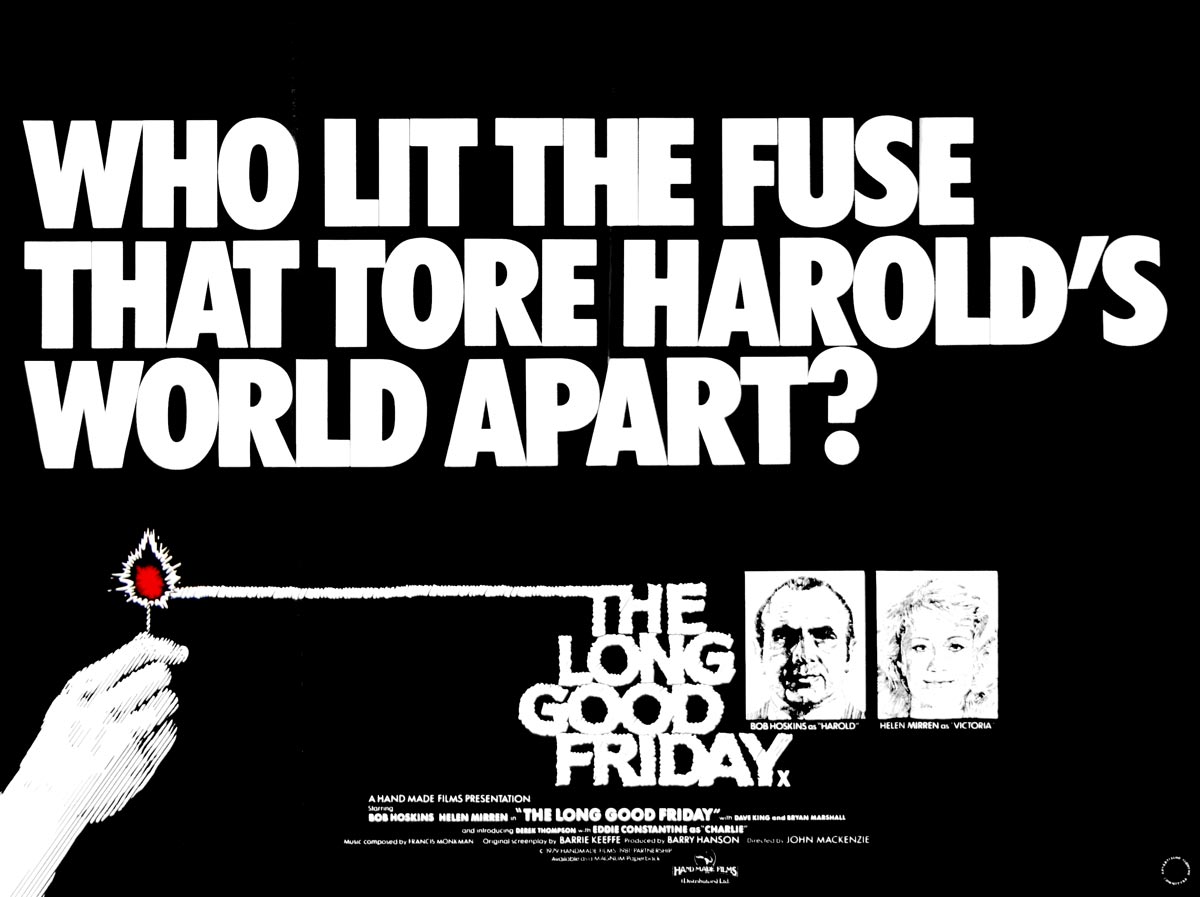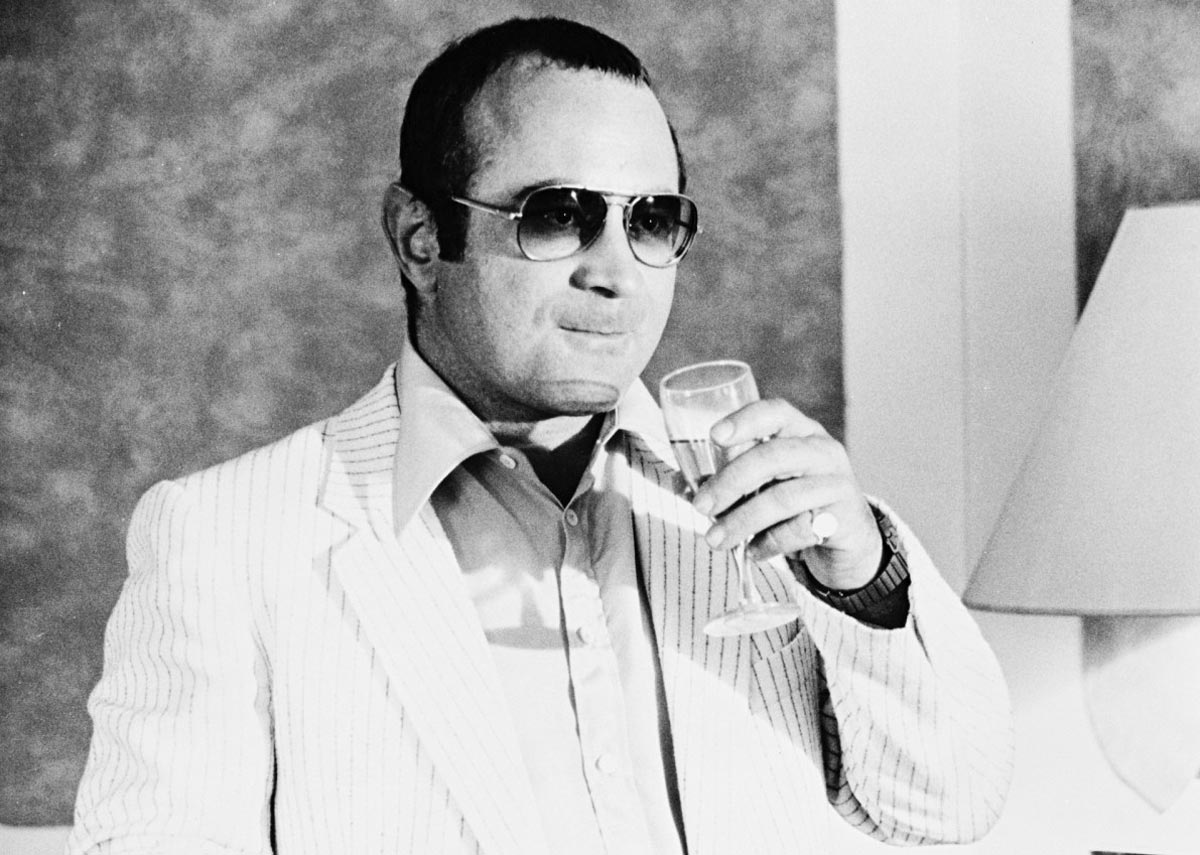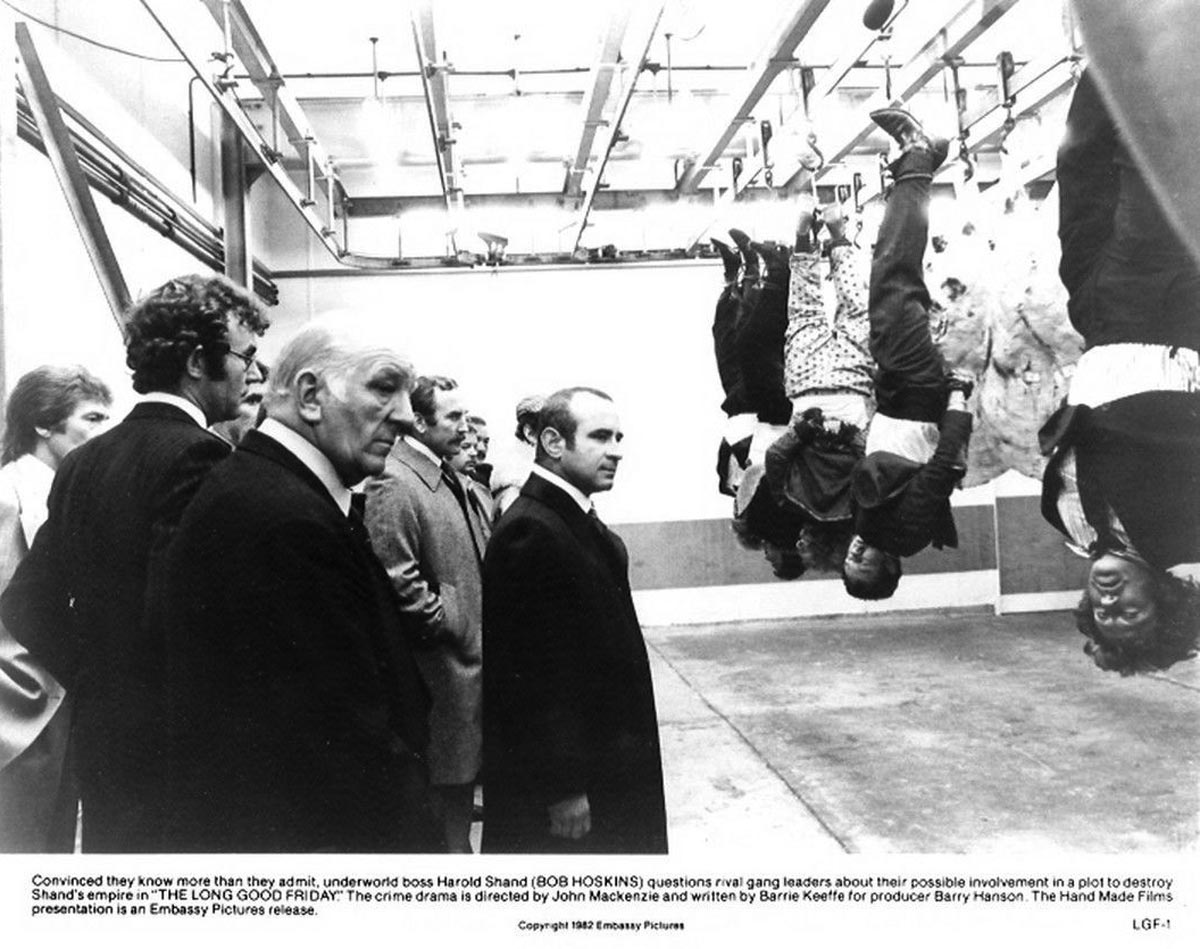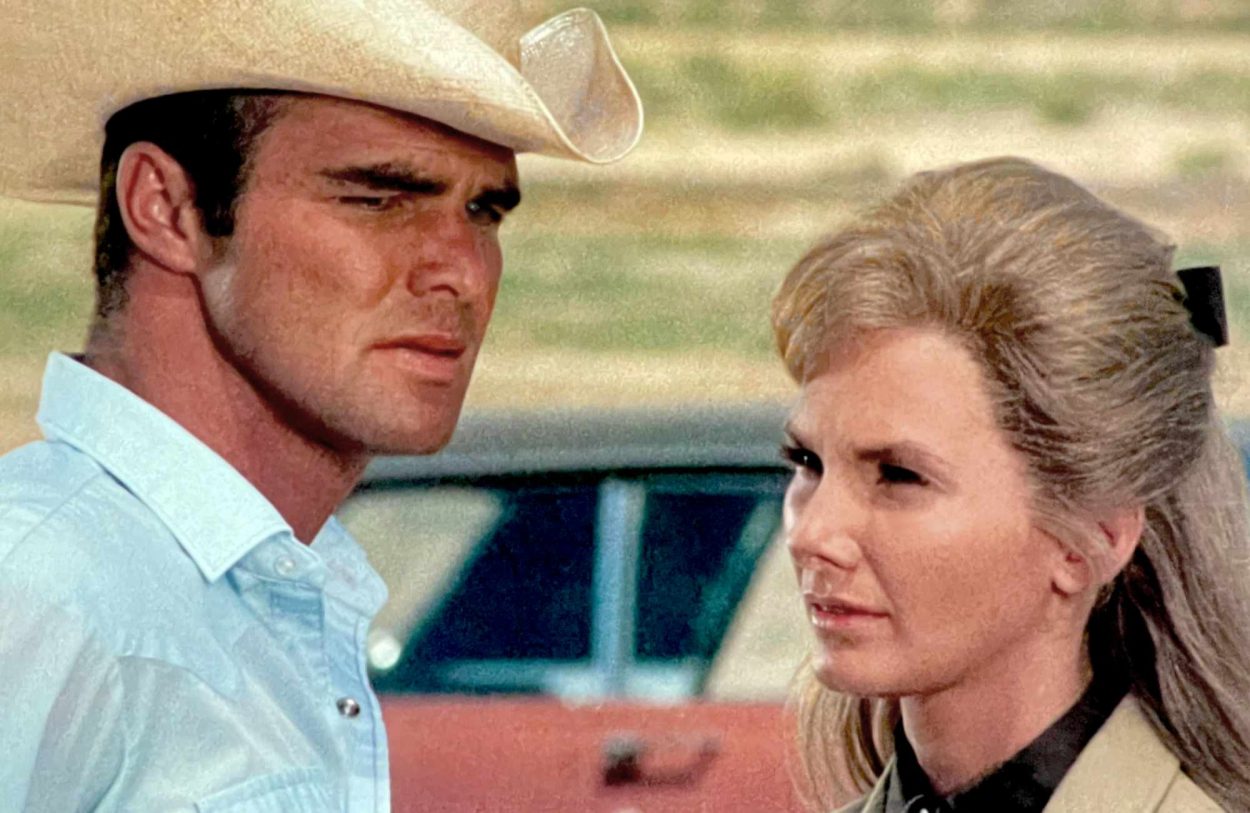“What I’m looking for is someone who can contribute to what England has given to the world: culture, sophistication, genius. A little bit more than an ‘ot dog, know what I mean?” – Harold Shand, The Long Good Friday
“When I made The Long Good Friday I’d reached a point where I was pissed off with what was going on in England and I wanted to do something about it. Harold had a morality, which had limits, he had violence, which had limits. But he was up against idealists who had no limits. The IRA were fighting for a cause. But criminals are just fighting for power, for money and that’ll only go so far. At the time I felt like I was up against a totally impossible regime, the Thatcherite regime.” – Bob Hoskins, 2000
Watching Bob Hoskins walk through the airport in John Mackenzie’s The Long Good Friday is one of those pleasures in cinema that doesn’t happen enough these days. And, really, watching Bob Hoskins do anything – walk, talk (that voice!), whisper, prepare a creepy dinner based on his dead mother, joke, yell, fall in love or spiral into an anger so intense that his neck looks bigger than it really was (and it already was big) and with his face so engorged that it could appear perilously close to bursting. He really could be gloriously terrifying. And charming – often at the same time. He shined and charmed and intimidated and moved you with his tenderness – he’d catch you off guard with it. He had those eyes too – nothing spectacular at first sight until he started emoting – orbs that, in a state of actorly rage, Helen Mirren said looked like, “two little shiny black olives.” Honoring her fellow actor and friend who passed away in 2014, Mirren, his co-star in The Long Good Friday, continued describing Hoskins as such: “Chock-a-block with testosterone, mucho machismo, a real bloke’s bloke, built like a brick outhouse, but with a gentleness, a sweetness and a love and respect for women that was very rare then, and is quite rare now.” That’s lovely – those seeming contradictions of the barrel-chested bruiser who claimed he was never as tough as he looked. As he put it: “You don’t end up with a face like this if you’re hard, do ya? This comes from having too much mouth and nothing to back it up with. The nose has been broken so many times… Oh yeah, plenty of courage. I’m the soppy sod who got up again.”

Just reading his self-description (from a terrific interview in The Guardian) makes me miss Bob Hoskins and miss his voice (if you can believe this insanity, at one point Hoskins’ voice was going to be dubbed for The Long Good Friday and the movie over-edited and dumped on TV). So watching The Long Good Friday again, and watch his swagger through the airport, that now famous opening entrance, was especially effecting. And he’s not even talking yet! I thought to myself, who is like this guy anymore? Who? And who ever was? An unlikely leading man in the vein of Edward G. Robinson, James Cagney, a bulldog (or, more, a pitbull) and that guy who either hugs or punches you (or both) after a long night of drinking, he was a stocky lug, short in stature but large in charisma, with a slangy eloquence that was rough-hewn melodious, a guy one loves to listen to – his rugged cadence was often full of wit and an energy that was both boot shaking and an absolute pleasure. Like this lovely/scary threat to a corrupt cop from Good Friday: “Don’t you ever tell me what I can or can’t do! Bent law can be tolerated for as long as they’re lubricating, but you have become definitely parched. If I was you, I’d run for cover and close the hatch, ’cause you’re gonna wind up on one of those meat hooks, my son.”
Onscreen Hoskins was immediately fascinating. He acted in theater, and was reportedly wonderful on stage, but the camera loved him, and his range from angry to lovable to creepy to humble to funny … (see Pennies from Heaven, Brazil, Mona Lisa, Nixon, Felicia’s Journey, Last Orders, Who Framed Roger Rabbit and, yes, Mermaids and more … forgive me for omitting other terrific performances), both as a leading man and as a character actor, however that applied to Hoskins, was impressive. Way back in his beginnings, a smart casting director saw his appeal when the young man accompanied a friend to an audition for a play with no intention of being an actor. And he got a part – the lead part in fact. He was born to do it, it seemed, and luckily his career happened. When you hear him tell the story of his life, it very well could not have. The son of a lorry driver and a nurse, he grew up in Finsbury Park in north London, he said that he might have robbed banks or simply been dead without acting. He was also considered more an instinctual actor and said as much in the same Guardian interview: “I ain’t got the faintest idea what the fuck is goin’ on, you know. I’ve read Stanislavsky, and I thought, well, this is obvious.” He’s asked if he meant “the Method” and Hoskins answered: “Nah! Nah, that’s Lee Strasberg, that’s bollocks! Like how to look busy. It’s just looking busy, impressing the boss. That’s bollocks, going through all this cobblers. Living it out and all that. Bollocks. Total cobblers!”
To show how much Hoskins brings to the screen, here how he’s written in the remarkable The Long Good Friday script: “Concorde at tunnel where passengers get off. Plane door opens. Stewardesses and Captain saying goodbye to the businessmen who come out. For that huge plane there’s only five? Transatlantic executive types. Just when we think everybody’s off, out comes HAROLD. Suntanned in smart suit and wearing sunglasses. We follow him down the corridor. He looks impressive.”
He does look impressive – and a few other elements to his bearing that are hard to articulate. It’s such a brief scene – set to Francis Monkman’s sax and synth music, and then there’s Hoskins’ face – hair cut close, balding, he’s merely surveying the airport for his friend set to meet him. He’s walking, yes, impressively, but there’s more to him than that. He’s not wearing sunglasses as the original script has detailed (you can see those “olive” orbs), but he does wear a nice creamy beige suit and struts – shoulder to shoulder, with a don’t fuck with me look (and we wouldn’t) until he sees his young friend, Jeff (Derek Thompson) – he smiles and gives him a hug. He doesn’t hit him. He will later – with a bottle – and then stabs the “Judas” in the neck with the broken shards.

That’s Hoskins as Harold Shand, East End kingpin who is attempting partnership with the American mafia, headed by Charlie (Alphaville’s Eddie Constantine) and mafia lawyer Tony (Stephen Davis). He’s needing aid and more money in developing the London docklands, among other things – he’s got big plans: “Our country’s not an island any more,” Harold states, “This is the decade in which London will become Europe’s capital, having cleared away the outdated. We’ve got mile after mile or acre after acre of land for our future prosperity. No other city in the world has got, right at its center, such an opportunity for profitable progress.” You like Harold – straight away – even if you shouldn’t – and the picture works his charm into some enthralling intercutting between Harold happily hosting potential associates on his luxury yacht with his tony girlfriend Victoria (Mirren), while his best friend Colin (a devilishly handsome Paul Freeman) is being murdered by an extremely attractive IRA hitman (played by young Pierce Brosnan). It’s a potent, even heartbreaking juxtaposition of scenes. After Colin performs an impressive high dive into a swimming pool, and gazes at the nice looking fellow swimmer, what could have become a sexy, romantic interlude for Colin turns into a deadly lure – Brosnan, feigning interest, is getting him that close only to kill him. For a 1980 crime film (the picture was completed in 1979) The Long Good Friday is refreshingly progressive about Colin’s homosexuality – Harold may have some other prejudices but he sure doesn’t give a toss about his friend being gay: “Belfast? What was he doing there? I know Colin fancies soldiers, but that’s taking his buggery a bit far, isn’t it?” During this same yacht festivity, his mother is almost killed – in church no less – her Rolls Royce blows up when her driver steps in before she does. Harry yells: “Who would do such a thing? It’s outrageous! Outside of church – you don’t go crucifying people outside of church – not on Good Friday!” Of course he loves his mama too.
More shit starts happening and it’s a joy just watching Hoskins’ face react. Harold’s pub blows up and everything is spiraling out of control – his fury is invigorating as it grows and grows, even as it scares us – the tension and death and disaster as Harold’s trying to look towards the future is a cinematic force in itself, he’s like his own special effect – Hoskins trying to figure just what in hell is going on. And then with the added extra stress to this pandemonium, he’s attempting to shield the drama from his potential investors (“It was the gas!” Victoria explains/lies almost hilariously). Understandably, Harold doesn’t want to appear so high risk, but, in grand understatement, that’s becoming increasingly difficult. Harold rounding up suspects leads to one of the picture’s standout scenes – men hanging from meat hooks in an abattoir, Harold berating the poor men as only Harold/Hoskins can do: “For more than ten years there’s been peace – everyone to his own patch. We’ve all had it sweet. I’ve done every single one of you favors in the past – I’ve put money in all your pockets. I’ve treated you well, even when you was out of order, right? Well now there’s been an eruption. It’s like fuckin’ Belfast on a bad night. One of my closest friends is lyin’ out there in the freezer. And believe me, all of you, nobody goes home until I find out who done it, and why!” (The shots of Harold walking through the cold storage and meat are beautifully constructed by cinematographer Phil Méheux, who films a magnificently gritty London – he also works some hand held shots wonderfully, particularly one that follows Harold around his boat). Soon enough, and in the same cold storage area, after putting these men through meat hook hell, Harold is informed by dirty cop Parky (Dave King) that it’s “not that lot” and the bombs have been checked – this is the IRA Harold is dealing with. His response is … just watch Hoskins. The man is so deeply in this role you wonder how he slept at night.

Watching Harold intimidate, crack wise (this movie is very, very mordantly funny), break down with Victoria (Mirren is more than just a moll here – she’s intelligent, strong and vulnerable too) while this gripping and prescient story unfolds is an enthralling joy, indebted to the brilliance of Hoskins and the excellent, at times, poetic script by Barrie Keeffe. Much has been written about how this movie and Keeeffe foresaw Thatcherism, and I suggest this excellent piece detailing predictions and changes in Sight & Sound by Lou Thomas. As he wrote: “Although the film was shot just before Margaret Thatcher came to power, Shand is perhaps the first truly Thatcherite antihero of British cinema. In one speech he says, ‘What I’m looking for is someone who can contribute to what England has given to the world.’ Aside from uttering that line, which one can imagine the former Prime Minister intoning to her dominated cabinet, Shand is devoted to the free market and ruthlessly destroys anyone standing in his way. When Shand comes up against the IRA, he’s dealing with a foe that can match his own dogged determination to win at all costs.”
Keeffe started out as a journalist in the East End in the 1960s, and he had seen a lot. He met the infamous Kray Brothers (an autographed picture of Hoskins was among Ronnie Kray’s possessions, hanging in his prison cell; it included a “Cheers” from the actor) and so the picture shows both keen insight into the realities of gangster life and deeply understands the entertaining dramatics of the gangster picture. It understands cinema. And, as mentioned, it’s not only prophetic, but also Shakespearean in lyricism and power dynamics and filled with religious allegory, not just with the title, but even a character spiked through the hands, a crucifixion death, which Keeffe states he really saw first hand (via the Krays) as a reporter. I love a scene where Shand slaps a grieving woman in a graveyard (a graveyard, next to a fresh grave) is bracing, weirdly humorous, sad and then, complex in terms of how much Harold is attempting to get to the bottom of things, questioning this woman, while sort of comforting her, and then taking in her sadness. After interrogating the woman, he asks what else she wants. She answers, “I just want him back!” and wails with her kids hugging her. Hoskins is so interesting here – he nods uncomfortably, seemingly too long (it’s not that long but he makes it seem so) and then says, “Get him a decent stone. Send me the bill.” He’s so good you’re not even sure how to feel.
You feel this frequently throughout the movie – this mixture of emotions, this vigor and terror and humanness that Hoskins injects into this complex kingpin. Bookending the movie – there’s his aforementioned entrance, that bulldog walking through the airport, and he grabs you by the throat right away. And then there’s his final scene, sitting in the back of his car with Brosnan’s IRA assassin intently holding a gun to his face with a crooked smile. The camera holds on Hoskins’ face in a powerful close-up showing the extraordinary range of emotions that are running through his head, moving from revealing to mysterious, messing with how we feel. We don’t really want him to die. As Hoskins said of this scene: “When I did my bit, [director] John [Mackenzie] actually told me that a camera can see you think … I don’t want you to act, I want you to think. I said, ‘You gotta be joking!’ None of us thought it was gonna work, but it did. And I realized then, the camera can actually read your mind … whatever you’re doing, it’s right.” Hoskins was right, and the camera was right, and it seems wrong that he’s no longer in front of it.
The Long Good Friday screens at the New Beverly Cinema on June 28 & 29.


